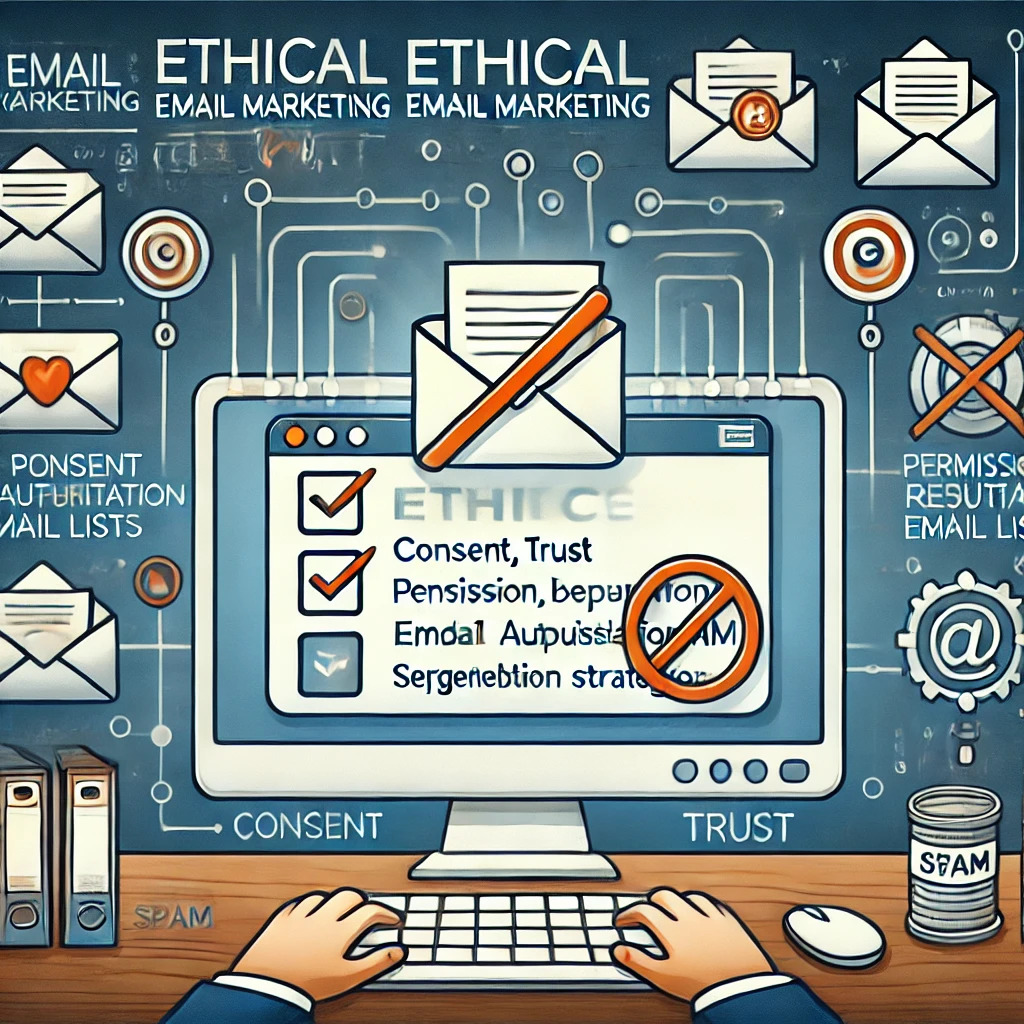Email marketing is a powerful tool for connecting with potential customers, but ensuring your emails reach your audience’s inbox instead of getting caught in spam filters can be challenging. To successfully navigate the Ethics of Email Marketing, it’s essential to understand the ethical practices that help avoid spam filters and enhance deliverability. This article explores the key elements of ethical email marketing, from understanding how spam filters work to building a permission-based email list and crafting content that resonates with subscribers. By following these strategies and adhering to the Ethics of Email Marketing, marketers can improve engagement, build trust, and avoid common pitfalls associated with spammy tactics.
Understanding Spam Filters: How They Work and What Triggers Them

Spam filters are an essential tool for keeping unwanted and potentially harmful emails out of users’ inboxes. They work by analyzing incoming messages against a set of criteria to determine whether they are legitimate or likely to be spam. These criteria include a variety of factors, such as the sender’s reputation, the content of the email, and the technical setup of the email itself. Understanding how spam filters function is key to ensuring your emails align with the Ethics of Email Marketing and avoid being marked as spam.
How Spam Filters Identify and Block Unwanted Emails
Spam filters use complex algorithms to analyze emails based on several factors. The primary goal is to protect the recipient from unwanted or harmful emails, such as those containing malware, phishing attempts, or irrelevant promotional content. Adhering to the Ethics of Email Marketing means avoiding these harmful practices. When an email is received, the filter first looks at the subject line, sender’s address, and body content to detect patterns commonly associated with spam.
Spam filters also examine metadata, such as whether the email contains images or attachments that are often used in spam campaigns. They compare these elements to known spam characteristics and flag emails that meet certain thresholds. For example, adhering to the Ethics of Email Marketing includes avoiding phrases like “Click here to win big” or “Guaranteed success,” as these can be flagged as spammy behavior.
Common Characteristics That Trigger Spam Filters
Several factors are known to trigger spam filters, and understanding these can help you avoid them while maintaining the Ethics of Email Marketing. Some common triggers include:
- Suspicious Subject Lines: Certain words or phrases in the subject line can immediately raise red flags. Overuse of capital letters, excessive punctuation, or phrases like “free,” “urgent,” or “limited-time offer” may make an email look spammy. Adhering to the Ethics of Email Marketing ensures you create subject lines that are relevant and honest.
- Excessive Links: Including too many hyperlinks in the body of an email can make it appear spammy. Spam emails often contain a large number of links to drive traffic to harmful websites. Limiting the number of links and ensuring they are relevant helps maintain the Ethics of Email Marketing and avoids triggering spam filters.
- Poor Sender Reputation: If your email domain or IP address has been associated with sending spam in the past, spam filters will likely flag your emails. Maintaining the Ethics of Email Marketing by building and upholding a good sender reputation is essential for deliverability.
The Role of Email Authentication Protocols (SPF, DKIM, and DMARC)
To ensure that your emails pass spam filters, it is essential to implement email authentication protocols. These help establish the legitimacy of your emails and protect your sender reputation, aligning with the Ethics of Email Marketing.
- SPF (Sender Policy Framework): This protocol allows the recipient’s email server to verify that the incoming email comes from an authorized server. Implementing SPF supports the Ethics of Email Marketing.
- DKIM (DomainKeys Identified Mail): DKIM adds a digital signature to your emails, confirming that the content of the email has not been altered in transit. This ensures compliance with the Ethics of Email Marketing.
- DMARC (Domain-based Message Authentication, Reporting & Conformance): DMARC builds on SPF and DKIM by specifying what should happen if an email fails authentication. Following DMARC guidelines exemplifies the Ethics of Email Marketing.
By adhering to these protocols and the Ethics of Email Marketing, you can enhance your email deliverability and avoid being caught in spam filters, ensuring your legitimate marketing emails reach their intended recipients. Maintaining the Ethics of Email Marketing not only protects your sender reputation but also fosters trust and engagement with your audience.
Building a Permission-Based Email List: Ethical Practices for Growing Your Subscriber Base

Building a permission-based email list is crucial for maintaining an ethical and effective email marketing strategy. It aligns with the Ethics of Email Marketing by ensuring compliance with laws like GDPR and CAN-SPAM while fostering trust with subscribers. A permission-based approach involves obtaining explicit consent from users before sending them marketing emails. This method adheres to the Ethics of Email Marketing by prioritizing transparency and respect for subscriber preferences. Here are some key practices for building a permission-based email list.
The Importance of Getting Explicit Consent Before Sending Marketing Emails (Opt-In)
Explicit consent, or “opt-in,” is a cornerstone of the Ethics of Email Marketing. By requiring users to voluntarily sign up, you show respect for their privacy and choices. This not only builds trust but also upholds the Ethics of Email Marketing, ensuring that communications are welcomed rather than intrusive.
An opt-in process, such as a newsletter signup form on your website, reflects the Ethics of Email Marketing by letting users willingly provide their email address in exchange for value, like discounts or exclusive content. Subscribers who opt-in are genuinely interested in your emails, boosting engagement and aligning with ethical standards.
How to Use Double Opt-Ins to Ensure Subscribers Genuinely Want to Receive Your Emails
A double opt-in process strengthens compliance with the Ethics of Email Marketing by confirming that subscribers truly want to hear from you. After a user submits their email address, they receive a confirmation email to verify their subscription. This extra step reinforces the Ethics of Email Marketing by ensuring consent and avoiding unintentional additions to your list.
Double opt-ins also align with the Ethics of Email Marketing by reducing spam traps and invalid emails, improving list quality. They prevent complaints and ensure compliance with laws like GDPR, which emphasize explicit consent.
Avoiding Purchased Email Lists and Focusing on Organic List-Building Strategies
Purchasing email lists directly conflicts with the Ethics of Email Marketing. Such lists often contain low-quality addresses, leading to high bounce rates and spam complaints. Sending emails without consent undermines the Ethics of Email Marketing, damaging your sender reputation and violating privacy laws.
Organic list-building, on the other hand, exemplifies the Ethics of Email Marketing. By offering incentives like discounts, eBooks, or engaging content, you attract genuinely interested subscribers. Lead magnets and social media promotions also adhere to the Ethics of Email Marketing by ensuring users voluntarily opt in.
Organic strategies create a subscriber base that aligns with the Ethics of Email Marketing, resulting in higher engagement and better conversions. This ethical approach prioritizes trust and respect for your audience.
In Conclusion ,By focusing on building a permission-based email list, you adhere to the Ethics of Email Marketing while cultivating a receptive audience. Practices like explicit opt-ins, double opt-ins, and avoiding purchased lists uphold the Ethics of Email Marketing and contribute to the long-term success of your campaigns. Following these ethical principles ensures your email marketing strategy remains effective and trustworthy
Crafting Relevant and Engaging Content: Balancing Personalization and Avoiding Spammy Tactics

Creating email content that resonates with your audience is a crucial aspect of email marketing success. Not only must the content be engaging, but it must also avoid spammy tactics that could lead to emails being filtered or marked as unwanted. By balancing personalization with clear, ethical messaging and strategically placing calls-to-action (CTAs), marketers can build stronger connections with their audience and drive better results. Here are some best practices for creating effective, engaging content that adheres to ethical guidelines.
Best Practices for Creating Email Content That Resonates with Your Audience
The first step in crafting engaging email content is ensuring that it is relevant to the recipients. Start by segmenting your email list based on factors like demographics, purchase history, or engagement level. This enables you to send tailored content that speaks directly to your audience’s needs and interests, increasing the likelihood of them opening and interacting with your emails.
For example, a retail brand could segment its list into categories like frequent shoppers, first-time visitors, or seasonal buyers. This allows you to send customized promotions, product recommendations, or content that speaks to their specific buying behavior. Relevant content feels more personal and increases engagement, as recipients are more likely to respond positively to offers or information they find valuable.
Additionally, avoid spammy techniques like using deceptive subject lines or excessive exclamation points. Subject lines like “FREE!!!!” or “Last chance to win!!!” are often flagged by spam filters and may alienate subscribers. Instead, focus on clear, concise subject lines that set the right expectations about the content inside.
The Value of Personalization and Segmentation to Improve Engagement
Personalization is a powerful tool in email marketing. When subscribers feel like the content is tailored to them, they are more likely to engage with the email and take action. Personalization goes beyond using just the recipient’s first name; it includes offering relevant content based on their preferences, behaviors, or past interactions with your brand.
Email segmentation is key to successful personalization. By dividing your audience into smaller groups based on shared characteristics, you can send more targeted, relevant content. For instance, sending a special offer on winter coats to customers who’ve purchased jackets in the past is a much more effective strategy than sending a generic email to the entire list. Segmentation helps you avoid sending irrelevant content, which in turn reduces unsubscribe rates and improves engagement.
How to Use Clear CTAs and Avoid Misleading or Excessive Promotional Language
Clear, concise calls-to-action (CTAs) are essential for guiding subscribers toward the next step in their journey, whether that’s making a purchase, reading a blog post, or signing up for a webinar. CTAs should be easy to find and aligned with the email’s content. Instead of overloading emails with multiple competing CTAs, focus on one primary action that you want recipients to take. For example, “Shop Now” or “Learn More” are straightforward and actionable.
Avoid using excessive promotional language or creating a sense of urgency that feels manipulative. Over-hyping an offer or using misleading language like “Act fast, limited time only!” can make your emails feel spammy and push subscribers away. Instead, focus on providing value in a transparent, honest way. Let your audience know what they can expect and why they should take action, without resorting to aggressive sales tactics.
In conclusion, crafting engaging email content requires a balance between personalization, relevance, and clear calls-to-action. By segmenting your list, tailoring your messages, and avoiding spammy tactics, you can build stronger relationships with your audience and improve the performance of your email campaigns. Keep your content honest, relevant, and focused on providing value to avoid alienating recipients and ensure the success of your email marketing efforts.
Conclusion
In conclusion, successful email marketing requires a delicate balance of ethical practices and technical know-how. Understanding how spam filters work and avoiding tactics that trigger them is the first step toward improving email deliverability. Building a permission-based list through opt-in practices ensures that you are engaging with a receptive audience, while personalization and clear content strategies help foster stronger connections. By implementing these practices, marketers can avoid the spam folder, enhance the customer experience, and ultimately achieve better results from their email marketing campaigns.

